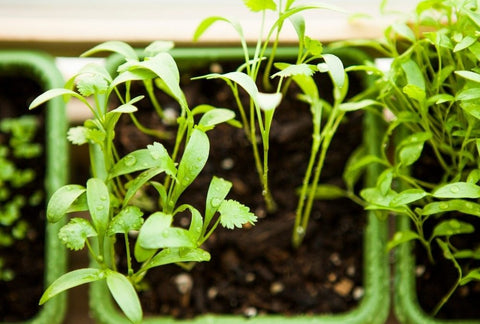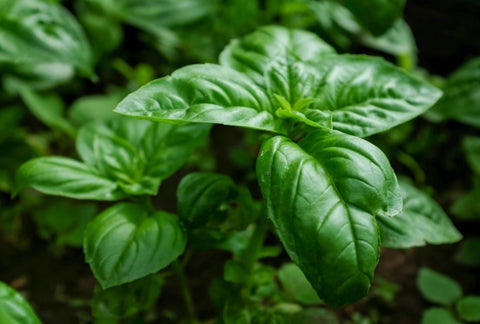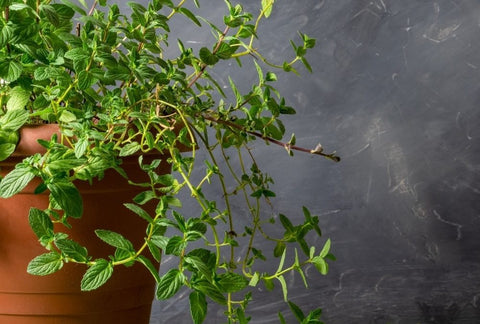Based on your genetic predisposition, you either love or hate cilantro. . Few are in-between.
If you’re still with us, then chances are you’re in the love camp. So let’s go on :) In this blog, we’ll be talking about everything you need to know in order to grow cilantro indoors; from basic facts, supplies, setup, steps to grow, caring for and harvesting it.
|
Plant type |
Annual |
|
Family |
Apiaceae |
|
Binomial name |
Coriandrum sativum |

Timing
Cilantro sprouts in 1-2 weeks. They can be harvested from Month 2+ on.

Part sun
Cilantro grows best with enough sun that is equivalent to 4+ hours of direct sun [DLI of 12+ mol/m²/day].

Care
Cilantro and most other herbs are beginner friendly. You’ll sprout, thin, and harvest.
TABLE OF CONTENTS
Ways to Grow Cilantro | Care and Maintenance for Cilantro | Timeline & Steps | Cultivars/Varieties
Ways to Grow Cilantro Indoors
Growing Cilantro Indoors Using Soil vs Hydroponics vs Microgreens
Grow Cilantro Indoors Using Soil
Cilantro plants, unlike basil, don’t do well in moist soil conditions. The roots are not accustomed to being too wet and will rot in boggy conditions. On the other hand, if the soil dries out completely the roots will die back and the plant won’t recover. This can catch you off guard because the plant’s not very expressive (its leaves don’t wilt) so it will look fine right up until it dies.
Grow Cilantro Indoors Using Hydroponics
Unlike other herbs, cilantro does not grow well in hydroponic systems such as the aerogarden. This is due to them not liking moist soil conditions.
Equipment Needed for Growing Cilantro Indoors Using Soil
We prefer using a Ceramic Self Watering Planter filled with a free-draining potting mix that self-regulates to keep the soil on the drier side, but with a little consistent moisture (and means no watering guesswork for you). Careful of wick-based self-watering planters with Cilantro - as they tend to be too wet.
To set one up:

- Fill up the planter with dry soil from the bag, gently tamping down the top.
- Dump the soil into a large mixing bowl and add water until the soil is moist, but not sopping wet (about ½ Cup)
- Mix in 1 tablespoon of the Balanced Blend Plant Food.
If you are using a regular pot instead, it should be a little bit bigger (at least 4" / 1 pint and will need drainage holes to prevent it from being overwatered. Let the top of the soil dry out between watering.
Growing Cilantro Indoors as Microgreens
Cilantro can definitely be grown as microgreens. In fact, most herbs can be grown as microgreens. In addition to the much shorter time to harvest (in days, not months), they are also more tender, making them better garnishes for your favorite dishes. Click here to learn more about the different types of microgreens (herbs being one of them), or grab a copy of our eBook to learn more about all the different ways you can grow cilantro (and more!) at home.
Care and Maintenance of Cilantro Indoors
Lighting for Growing Cilantro Indoors
Out of all edible plants, Cilantro plants have some of the lowest light needs - but they still need to be in a very bright place that gets at least 4+ hours of direct sunshine. While you might be lucky enough to have a bright windowsill that works, most of us need to use a grow light (especially during the winter). For an introduction to grow lights, head over to our post on grow lights for indoor gardeners. We’ve also got a buying guide for screw in types, but to keep things simple in this guide, we’ll just provide directions for the 24W Screw in Bulb by Sansi, which we think is a good middle-of-the-road option.

How bright should your grow light be?
Cilantro plants need the equivalent of 4+ hours of direct sunlight [DLI of 12+ mol/m²/day] to grow their best. In order to provide an equivalent amount with a grow light, it needs to be pretty bright! The 24W Sansi bulb should be placed 6 inches away from the top of the plant. This will give your PPFD (the standard measure of brightness) of 500 μmol/m²/s.
How many hours per day do your Cilantro plants need under a grow light?
Cilantro plants are known as “long-day”. When they sense over 12 hours of light per day, they’ll start the end of their lifecycle and work on making seeds. We want to keep them in an earlier stage so we can keep harvesting the leaves, so we recommend setting up a timer to leave it on for only 8 hours per day.
Temperature Needed by Your Indoor Cilantro
Extend your harvest by keeping the Temperatures Cool
Cilantro is known as a “cool weather crop.” If it senses warming temperatures it will “bolt” - send up flowers and become bitter in the process. Where you plant them can have some effect on the temperature - lower positions on a growing rack and ceramic planters tend to run cooler. It's best to avoid windows that get really hot (like bay windows)
Water and Humidity
Herbs such as cilantro thrive on adequate amount of moisture but can suffer if they’re waterlogged, so make sure to water them just enough, especially if you’re using soil. To avoid your cilantro being waterlogged, make sure to use a pot with drainage, or just use self-watering pots, as mentioned above.
Nutrients and Fertilizers
Cilantro likes to start with nutrients that are equal parts nitrogen, phosphorus, and potassium (with NPK numbers like 10-10-10). For this Balanced Blend we recommend: Dr Earth All Purpose
Once they are growing, it’s better to use plant food that is high in nitrogen (with NPK numbers like 10-5-5). For this Herb Blend, we recommend: Joyful Dirt All Purpose
Moving Your Cilantro Plant Outdoors
Cilantro mostly thrives in colder temperatures, as we talked about above. So we suggest moving your cilantro plant outdoors only when the temperature is not that warm anymore, preferably during spring or fall, when the temperatures are at around 50-85℉ (10-26℃). To learn more about how to grow your cilantro outdoors, check this out. (coming soon!)
Timeline and Steps on How to Grow Cilantro Indoors
Best Setup for Cilantro Plants
Below is the best setup (and a very easy one!) for growing your cilantro plants indoors. You’ll need:
Planter:
Ceramic Self Watering Planter or pot that is at least 4" / 1 pint.
Soil:
Free-Draining Mix
Plant Food:
At the start: Balanced Blend. This should be equal parts nitrogen, phosphorus, and potassium (with NPK numbers like 10-10-10).
Ongoing: Herb Blend. This should be high in nitrogen (with NPK numbers like 10-5-5).
Grow Light:
A strong grow light that can give the equivalent of 4+ hours of direct sun [DLI of 12+ mol/m²/day].
Growing Cilantro Indoors: Seed vs Cutting vs Nursery Plant
Growing cilantro indoors can be hard at first, especially if you’re not sure where to start. New Cilantro plants can be started from seed, propagated from an established plant, or purchased live at many garden centers. We prefer to sprout from seed or propagate from a stem cutting, as it results in plants that are adapted to your growing conditions and limit the chances that you accidentally bring home pests.
How to Plant Cilantro seeds

Cilantro grows quickly from the seed. Plant 5 sites in a 4" / 1-pint container. In larger containers, space sites 1" apart. For each site plant 2 seeds 1/4 inches deep. Keep the soil warm ( 55-70°F, ideally 65°F). Sprouts typically appear in 8 days but can be as quick as 6 days or as long as 10 days depending on your conditions.
Green Thumb Guide: Soak Your Cilantro Seeds Before Planting
To speed things up, you can soak them in water for 1-2 days before planting.
Propagating Cilantro: How to Clone from a Stem Cutting

If you’ve already got a Cilantro plant you love (or a friend does!) you can easily “clone” it with just sharp scissors and a clean glass of water. First, cut a couple 6” shoots of new growth (avoid anything woody). Next, remove the lower leaves, so the bottom half is just stem. Place in a glass of 3” of water, making sure the cut leaf spots are underwater.
Place the glass on a bright windowsill and change the water every few days. In a couple of weeks, roots should emerge and you can transplant them into your container. While using additional rooting hormones won't hurt, it’s not necessary with Cilantro plants.
- Cut 6” section of new growth
- Remove leaves halfway and place them in the water on a sunny window sill
- Wait 14 days for a few ½ inch roots to form and carefully transplant into its final container.
How to Transplant Cilantro

Live starter plants give you a big jump start on your first harvest. When you’re in a garden center - pick the bushiest plant available (tall and lanky ones will be weak growers) and give it a good inspection for pests. Leaves should be dark green without holes, spots, or curled edges. A best practice is to actually “quarantine” your plant for about a week after bringing it home to make sure it's free and clear of ride-on pests.
Ensuring it’s pest and disease-free it’s time to transplant your seedling into its final home.
- Remove some soil from its final planter - leaving enough space for the bottom of the seedling to be just higher than the soil surface.
- Hold on to the base of the stem with one hand, and turn the pot over while gently pulling the seedling. Giving the pot a few squeezes can help dislodge it.
- Place in its final container and fill around it with soil so that it’s tight, but not compacted.
Week 1-2: Check for Sprouts
You could see seedlings in as little as 6 days (though 8 days is more typical). If it’s been 10 days and you still don’t have any sprouts, it’s likely that your setup is too cold.
Week 3: Thin Your Seedlings

Thin your planter to only have 1 seedling per site - leaving the largest plant. If you are using the recommended planter (at least 4" / 1 pint) this will mean you’ve got 5 plants after thinning. By getting rid of the smaller seedlings, you’re allowing the biggest and strongest one to flourish by reducing its competition for water, food, and space.
If your seedlings are under 1 inch, stretching out, or folding over, it’s likely that they don't have quite enough light.
Week 4: How to Prune Cilantro

You’ll notice how all the stems and leaves of Cilantro grow from a single, central point (called radial growth). The plant puts out new leaves in the center and pushes old leaves outward, getting bigger and bushier over time.
Pruning and harvesting are one-in-the-same as Cilantro. Once the plant has at least 3 separate stems coming from the base take one of the outside leaves and cut it close to the base (½” above is fine). It’s good to leave at least 2/3rds of the plant left to regrow. If you only want a tiny amount of herbs, you also can clip the top of an individual stem – just be sure to leave some leaves on that stem, otherwise it won’t grow back.
Month 2+: How to Harvest Cilantro
As soon as plants are about 4 inches you can start harvesting. Pick the largest leaves and cut them about 1 inch from the base. Pick from the outside when taking an entire leaf.
How to Use Your Freshly-harvested Cilantro in Cooking
As we all know, cilantro is a staple herb used by the most prominent chefs around the world to ordinary food lovers at home. Cilantro can be used in many ways:
- Spicing up your dips and sauces
- Added as toppings for your pasta
- Added as a garnish to any soup or rice dish
Check out some more of our favorite cilantro recipes here.
How to Preserve Cilantro
There are several ways to preserve or keep your herbs fresh, and here are just some of the easiest and the ones we recommend the most:
- Lazy person technique. It involves keeping the fresh herbs in their original packaging and simply storing them in the fridge.
- Storing the herbs in a glass of water inside the fridge. You can do this by cutting the end of the stem of your herb, filling a glass jar or cup with water, and placing your herb inside. Almost like a vase or bouquet of herbs!
- Keep in a glass of water under natural lighting.
- Wrap loosely in a damp paper towel.
- Freeze them herbs! Yes, you can freeze fresh herbs such as cilantro to use at a later time! All you need are some ice cube trays and a freezer, and you’re all set.
Learn more about how to preserve and keep your herbs and cilantro fresh here.
Month 5-6: End of Life
As cilantro matures, the leaves will change to a feathery shape, reminiscent of dill. The mature leaves are much more bitter than the younger leaves, but you can use the seeds as coriander in your cooking. If you want to know why cilantro bolts and what you can do about it, check this out.
If you’d like to learn about the dozens of other herbs, fruits, and vegetables that you can grow indoors then grab a copy of our free eBook below.
Best Cilantro varieties to grow inside
Growing cilantro indoors is no problem! The following are the four most popular varieties of cilantro or coriander. Santo and Indian Summer are popular due to their slow-bolting properties, while the Vietnamese Cilantro and Culantro are well-liked because of their flavor.
|
Variety |
Santo |
Indian Summer (papalo) |
Vietnamese Cilantro |
Culantro |
|
Why We Like Them |
The benchmark variety for field-grown coriander. It is probably the best variety for leaf production as the plant combines very slow bolting with an upright habit and excellent flavor. |
It’s easy to grow, and provides an ample harvest of leaves—sometimes a little too ample, so don’t worry about growing too many plants. |
Tastes a little like culantro but is more peppery, spicy, and lemony. This herb is also known as hot mint. |
Rich in calcium, iron, carotene, and riboflavin and its leaves are widely used as a food flavoring and seasoning herb for meat and many other foods. |
|
Purchase Link |
We hope that this blog has given you everything you need to know about growing cilantro indoors. In case you have any questions, just leave a comment below.











There are no comments for this article. Be the first one to leave a message!